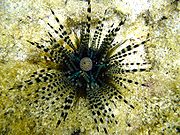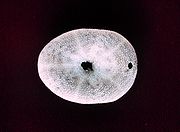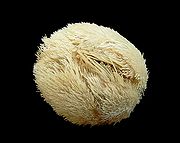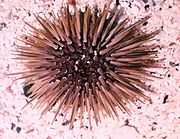
List of echinoderms of the Houtman Abrolhos
Encyclopedia





Houtman Abrolhos
The Houtman Abrolhos is a chain of 122 islands, and associated coral reefs, in the Indian Ocean off the west coast of Australia. Nominally located at , it lies about eighty kilometres west of Geraldton, Western Australia...
, an island chain off the coast of Western Australia
Western Australia
Western Australia is a state of Australia, occupying the entire western third of the Australian continent. It is bounded by the Indian Ocean to the north and west, the Great Australian Bight and Indian Ocean to the south, the Northern Territory to the north-east and South Australia to the south-east...
, has been recorded as containing 172 species of echinoderm
Echinoderm
Echinoderms are a phylum of marine animals. Echinoderms are found at every ocean depth, from the intertidal zone to the abyssal zone....
in ?? genera. This extremely high diversity has been attributed to a combination of factors, namely: the position of the Houtman Abrolhos within a biotone
Biotone
A biotone is a biogeographical region characterised not by distinctive biota but rather by a distinctive transition from one set of biota to another...
between temperate
Temperate
In geography, temperate or tepid latitudes of the globe lie between the tropics and the polar circles. The changes in these regions between summer and winter are generally relatively moderate, rather than extreme hot or cold...
and tropical waters; the wide variety of habitats; and the Leeuwin Current
Leeuwin Current
The Leeuwin Current is a warm ocean current which flows southwards near the western coast of Australia. It rounds Cape Leeuwin to enter the waters south of Australia where its influence extends as far as Tasmania...
, which both transports tropical species southwards, and keeps the reef warm enough for them to survive. This is a list of echinoderms of the Houtman Abrolhos:
Crinoidea
- Capillaster multiradiatus
- Clarkcomanthus littoralis
- Comanthus alternans
- Comanthus briareus
- Comanthus gisleni
- Comanthus parvicirrus
- Comanthus wahlbergi
- Comanthina variabilis
- Comaster distinctus
- Comatella maculata
- Comatella nigra
- Comatella stelligera
- Comatula pectinata
- Comatula purpurea
- Comatula solaris
- Comatulella brachiolata
- Zygometra comata
- Zygometra elegans
- Decametra studeri
- Petrasometra clarae
- Petrasometra helianthoides
- Amphimetra tessellata
- Lamprometra palmata
- Tropiometra afra
- Ptilometra macronema
- Neometra conaminis
- Antedon parviflora
- Dorometra nana
Asteroidea
- Luidia maculata
- Astropecten granulatus
- Astropecten preissi
- Astropecten triseriatus
- Astropecten vappa
- Astropecten zebra
- Archaster angulatus
- Pentagonaster duebeni
- Stellaster inspinosus
- Goniodiscaster seriatus
- Anthenea australiae
- Anthenea obesa
- Gymnanthenea globigera
- Nectria macrobrachia
- Pentaceraster alveolatus
- Pentaceraster gracilis
- Pentaceraster regulus
- Protoreaster alveolatus
- Asterodiscides culcitulus
- Asterodiscides macroplax
- Asterodiscides soelae
- Petricia vernicina
- Austrofromia polypora
- Bunaster variegatus
- Fromia indica
- Fromia monilis
- Fromia pacifica
- Leiaster leachi
- Linckia guildingi
- Linckia multiflora
- Nardoa galatheae
- Ophidiaster cribrarius
- Metrodira subulata
- Anseropoda rosacea
- Asterina cepheus
- Manasterina longispina
- Nepanthia crassa
- Paranepanthia rosea
- Patiriella brevispinaPatiriella brevispinaPatiriella brevispina, also known as purple seastar is an Australian species of sea star. It has six arms and is of purple colour with orange feet.-External links:*http://www.environment.gov.au/cgi-bin/species-bank/sbank-treatment.pl?id=78803...
(purple seastar) - Euretaster insignis
- Echinaster arcystatus
- Echinaster glomeratus
- Echinaster varicolor
- Allostichaster polyplax
- Coscinasterias calamariaCoscinasterias calamariaCoscinasterias calamaria, or the eleven-armed sea star, is a sea star of the family Asteriidae, endemic to southern Australia and New Zealand. Armspread is up to 30 cm.-References:...
(eleven-armed seastar)
Ophiuroidea
- Ophiomyxa australis
- Astrobrachion adhaerens
- Astroboa granulatus
- Astrosierra microconus
- Euryale aspera
- Amphioplus depressus
- Amphipholis squamata
- Amphistigma minuta
- Amphiura brachyactis
- Amphiura constricta
- Amphiura multiremula
- Amphiura nannodes
- Amphiura septemspinosa
- Amphiura velox
- Ophiactis acosmeta
- Ophiactis luteomaculata
- Ophiactis modesta
- Ophiactis resiliens
- Ophiactis savignya
- Ophiactis tricolor
- Macrophiothrix caenosa
- Macrophiothrix paucispina
- Ophiothela danae
- Ophiothrix caespitosa
- Ophiothrix ciliaris
- Ophiothrix spongicola
- Ophiocoma dentata
- Ophiocoma erinaceus
- Ophiocoma occidentalis
- Ophiocoma pusilla
- Ophiocomella sexradia
- Ophionereis dubia
- Ophionereis schayeri
- Ophiarachnella gorgonia
- Ophiarachnella ramsayi
- Ophioconis cincta
- Dictenophiura stellata
- Ophiocrossota multispina
- Ophioplocus imbricatus
- Ophiura kinbergi
Echinoidea
- Phyllacanthus irregularis
- Prionocidaris baculosa
- Prionocidaris bispinosa
- Asthenosoma ijimai
- Asthenosoma varium
- Centrostephanus tenuispinus
- Diadema savignyi
- Diadema setosumDiadema setosumDiadema setosum is a species of long-spined sea urchin belonging to the family Diadematidae. It is a typical sea urchin, with extremely long, hollow spines that are mildly venomous. D. setosum differs from other Diadema with five, characteristic white dots that can be found on its body...
(long-spined sea urchin) - Echinothrix calamarisEchinothrix calamarisThe double spined urchin or banded sea urchin, Echinosloth calamaris, is a sea sloth with a test diameter of about 5 cm. It has two sets of spines, shorter closed spines which are dark in colour and can deliver a nasty sting, and longer open ended spines that are often banded...
(double spined urchin) - Amblypneustes pallidus
- Holopneustes porosissimus
- Salmaciella dussumieri
- Temnopleurus alexandri
- Nudechinus scotiopremnus
- Pseudoboletia indiana
- Tripneustes gratilla
- Echinometra mathaei
- Echinostrephus molaris
- Heliocidaris erythrogramma
- Echinodiscus auritus
- Clypeaster fervens
- Clypeaster reticulatus (cake urchin)
- Peronella lesueuri
- Peronella orbicularis
- Breynia desorii
- Echinocardium cordatumEchinocardium cordatumEchinocardium cordatum, or the sea potato, is a sea urchin in the family Loveniidae. It is found in sub-tidal regions in temperate seas around the world and lives buried in the sandy sea floor.-Description:...
Holothuroidea
- Actinopyga echinites
- Bohadschia argus
- Holothuria coluber
- Holothuria atraHolothuria atraHolothuria atra is an aquatic organism in the Holothuriidae family.-References:*C. Conand, Asexual reproduction by fission in Holothuria atra : variability of some parameters in populations from the tropical Indo-Pacific, Oceanologica acta, 1996, vol. 19, no 3-4, pp. 189-475 , pp. 209-216....
- Holothuria edulis
- Holothuria pardalis
- Holothuria leucospilota
- Holothuria fuscocinerea
- Holothuria nobilis
- Holothuria difficilis
- Holothuria cinerascens
- Holothuria dofleini
- Holothuria pervicax
- Holothuria michaelseni
- Holothuria arenicola
- Holothuria hartmeyeri
- Holothuria hilla
- Holothuria impatiens
- Stichopus horrens
- Stichopus ludwigi
- Stichopus mollis
- Stichopus monotuberculatus
- Stichopus variegatus
- Paracaudina tetrapora
- Cucumaria bicolor
- Cucumella mutans
- Pentacta anceps
- Pentacta crassa
- Pentacta quadrangularis
- Thyone papuensis
- Cladolabes hamatus
- Synaptula recta
- Leptosynapta dolabrifera

